Inelastic collisions
Collisions in 1D
Problem:
A particle of mass m1 and velocity u1 collides with a
particle of mass m2 at rest. The two particles stick together.
What fraction of the original kinetic energy is lost in the collision?
(Simplify the answer as much as possible.)
Solution:
- Concepts:
Momentum conservation
- Reasoning:
In an inelastic collision kinetic energy is not conserved,
but momentum is conserved.
- Details of the calculation:
m1u1
= (m1 + m2)v.
Ef = ½ (m1 + m2)v2,
Ei = ½ m1u12.
Fraction
of energy lost = (Ei - Ef)/Ei = 1 - m1/(m1
+ m2) = m2/(m1 + m2).
Problem:
A particle of mass m traveling with (non-relativistic) velocity u1
makes a head-on collision with a second particle of mass M, which is at rest in
the laboratory. If the collision is completely inelastic, what fraction of the
original kinetic energy remains after the collision?
Solution:
- Concepts:
Inelastic collisions, momentum conservation
- Reasoning:
In inelastic collisions: momentum is conserved, mechanical energy is not
conserved.
- Details of the calculation:
Assume the particle is initially traveling in the positive x-direction.
Before the collision: pi = mu1, Ei = ½mu12.
After the collision: pf = (m+M)v = mu1. Ef
= ½(M+m)v2 = ½[m2/(M+m)]u12.
Ef/Ei = m/(M+m).
Problem:
A 36 g bullet with a speed of 350 m/s strikes a 8 cm thick
fence post. The bullet is retarded by an average force of 3.6*103 N
while traveling all the way through the board.
(a) What speed does the bullet have when it emerges?
(b)
How many such boards could the bullet penetrate?
Solution:
- Concepts:
Newton's second law, F = ma, motion with constant acceleration
in one dimension
- Reasoning:
For motion with constant acceleration the equations of kinematics
yield
vxf2 = vxi2 + 2ax(xf
- xi).
- Details of the calculation:
(a) (xf - xi) = 0.08 m, vxf2 =
(350 m/s)2 - 2*(0.08 m)(3.6*103 N)/( 36*10-3
kg),
vxf = 326.34 m/s.
(b) vxf = 0, (350 m/s)2 =
2*d(3.6*103 N)/( 36*10-3 kg), d = 0.6125 m.
# of boards the bullet can penetrate = 7, (d/0.08 = 7.65)
or
Work-kinetic energy theorem: <F>d = ½mvi2.
Problem:
Board A is placed on board B as shown. Both boards slide, without
moving with respect to each other, along a frictionless horizontal
surface at a speed v. Board B hits a resting board C "head-on."
After the collision, boards B and C move together, and board A slides
on top of board C and stops its motion relative to C in
the position shown on the diagram. What is the length of each
board? All three boards have the same mass, size, and shape. It is
known there is no friction between boards A and B; the coefficient of
kinetic friction between boards A and C is μk.

Solution:
- Concepts:
Inelastic collisions, momentum conservation, friction
- Reasoning:
Board B and C collide inelastically. Board A slides over boards B and C,
and we have sliding friction. Solve the problem in a inertial frame.
- Details of the calculation:
After the collision boards B and C stick together and move with speed v/2 in
the lab frame (momentum conservation). There is no friction between A and
B. Board A moves with speed v in the lab frame. The CM frame moves with
velocity 2v/3 towards the right. In the CM frame board A moves with
velocity v/3 towards the right and boards B and C move with velocity v/6
towards the left right after the inelastic collision. Let us work in that
frame. Let the right edge of board A be at x' = 0 at t = 0, right after the
collision. At time t, when the right edge of the board A is at x', the
force on the board is the force of friction μN = μmg3x'/(2L) directed
towards the left.
L is the length of each board, 3x'/(2L) represents the fraction of the top
board that is supported by the surface with friction.
The acceleration is a = F/m, d2x'/dt2 = -μg3x'/(2L).
The solution to this differential equation is
x' = x'0sinωt, ω = (3μg /(2L))½, v' = ωx'0cosωt,
with the initial conditions
x'(0) = 0, v'(0) = v/3 = ωx'0.
x'0 = v/(3ω) = v'(0)/(3μg/(2L))½.
When x' = x'0, v' = 0. x'0 therefore is the (2/3) of
length of the board, x'0 = 2L/3.
2L/3 = v'(0)/(3μg/(2L))½, 2L2/9 = v'(0)2L/(3μg).
The length of the board is L = 3v'(0)2/(2μg) = v2/(6μg)
You can also use the work-kinetic energy theorem. We have
in the CM
frame
F = -Cx', C = 3mμg/(2L). C(2L/3)2/2 = ½m(v/3)2, L
= v2/(6μg).
Problem:
An hour glass sits on a scale. Initially all the sand (mass m) in the glass
(mass M) is held in the upper reservoir. At t = 0, the sand is released. If it
exits the upper reservoir at a constant rate dm/dt = -λ, draw (and label
quantitatively) a graph showing the reading of the scale at all times t > 0.

Solution:
- Concepts:
Newton's 2nd law, F = dp/dt
- Reasoning:
The reading of the scale is determined by the amount of sand not falling
freely and the force required to reduce the momentum of an amount of sand
dm reaching the bottom to zero in the a time interval dt.
- Details of the calculation:
Each grain of sand falls a distance h.
It therefore falls for a time
interval t1 = (2h/g)½. The first grain hits the
bottom at t = t1.
For 0 < t < t1, the scale reads W1 = (M + m)g - λgt.
W1 decreases linearly from (M + m)g to (M + m)g - λ(2gh)½.
At time t2 = m/λ, all the sand has left the upper reservoir.
For
t1 < t < t2, W2 = (M + m)g - λgt1
+ v|dm/dt|.
(M + m)g - λgt1 is the weight of the sand that is not falling and
v|dm/dt| is the force required to reduce the momentum of the amount of sand
|dm|
= λdt reaching the bottom in the time interval dt with speed v = (2gh)½
to zero in the time interval dt.
v|dm/dt| = (2gh)½λ. λgt1 = λg(2h/g)½ =
(2gh)½λ.
Therefore W2 = (M + m)g. W2 is constant.
At time t3 = t2 + t1 all the sand has
reached the bottom. For t2 < t < t3, W3 =
W2 + λg(t - t2) .
W3 increases linearly from (M + m)g to (M + m)g + λ(2gh)½.
For t > t3, W4 = (M + m)g = constant.
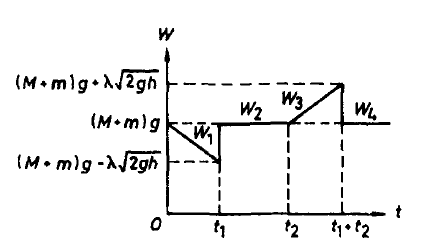
Problem:
A 15.2 g bullet hits a 0.463 kg block from below. The initial speed of
the bullet is 624 m/s and it emerges from the block at 131 m/s.
(a)
How high does the block rise?
(b) If the block is 2.34 cm thick,
estimate the average force on the block. Assume that the bullet passes
completely through before the block moves appreciably.

Solution:
- Concepts:
Momentum conservation, impulse
- Reasoning:
In the collision between the bullet and the block momentum
is conserved. The collision time is very short.
This is a 1-dimensional
problem.
- Details of the calculation:
(a) m = 0.0152 kg , M = 0.463 kg, mvi
= mvf + Mv.
v = m(vi - vf)/M =
0.0152*(489 m/s)/ 0.463 = 16 m/s.
The initial speed of the block is v =
16 m/s.
It rises to a height h = v2/(2g) = 13.15 m.
(b)
The block receives an impulse Δp = Mv in the time interval Δt.
Δt is the
time it takes the bullet to pass through the block,
Δt = 2*(0.0234 m)/(vi
+ vf) = 6.23*10-5 s, assuming uniform deceleration.
F = Δp/Δt = 1.19*105 N.
Collisions in 2D
Problem:
A particle of mass m strikes a frictionless, smooth, hard surface at an angle
θ from the surface normal. The particle bounces off with coefficient of
restitution ε. (The coefficient of restitution is defined as the ratio of
the magnitudes of the velocity components along the normal to the plane of contact after and
before the collision.) Find the rebound angle for the particle as it
leaves the surface.
Solution:
- Concepts:
Definition: coefficient of restitution
- Reasoning:
This is an inelastic collision. We are asked to find the
rebound angle when given the coefficient of restitution.
- Details of the calculation:
ε = |v2|/|v1|, v1
is the velocity component of the particle toward the floor before collision
and v2 is the velocity component of the particle away from the
floor after the collision.
Before the collision: tanθ = |vx|/|vy|.
After the collision: tanθ' = |vx'|/|vy'| = |vx|/(ε|vy|)
= (1/ε)tanθ.
Since ε < 1, the rebound angle is bigger than the incoming
angle.
Problem:
A 90 kg fullback running east with a speed of 5 m/s is tackled by a 95 kg
opponent running north with a speed of 3 m/s. If the collision is
perfectly inelastic, calculate the speed and the direction of the players just
after the tackle.
Solution:
- Concepts:
Inelastic collision, conservation of momentum
- Reasoning:
If a component of the total external force acting on a
system is zero, then the corresponding component of the total momentum is
conserved. We assume that the horizontal component of the external force
can be neglected during the collision.
- Details of the calculation:
The initial momentum of player 1 is
p1
= (90 kg 5 m/s)i = (450 kgm/s)i.
The initial momentum
of player 2 is p2 = (95 kg 3 m/s)j = (285 kgm/s)j.
Momentum is conserved, the final momentum p of both players is
p =
p1 + p2.
p
= (m1 + m2)v.
v = (2.432 m/s)i + (1.54 m/s)j.
v2 =
8.29(m/s)2, v = 2.88 m/s.
The speed of the players after the
collision is 2.88 m/s.
tanθ = py/px = 285/450 =
0.63, θ = 32.34o.
Their direction of travel makes an angle θ=
32.34o with the x-axis. (The x-axis is pointing east.)
Problem:
After a completely inelastic collision between two objects of equal mass,
each having initial speed v, the two move off together with speed v/3. What was
the angle between their initial directions?
Solution:
- Concepts:
Conservation of momentum
- Reasoning:
The external force acting on the system is zero, the total momentum is
conserved.
- Details of the calculation:
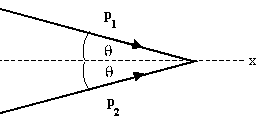
p1x + p2x = pfx = pf, p1y
+ p2y = 0.
2mv cosθ = 2mv/3, cosθ = (1/3), θ = 70.5o.
The angle between their initial directions is 2θ = 141o.
Problem:
The mass of the blue puck is 20% greater than the mass of the green one.
Before colliding, the pucks approach each other with equal and opposite momenta,
and the green puck has an initial speed of 10 m/s. Find the speed of the
pucks after the collision, if half the kinetic energy is lost during the
collision.
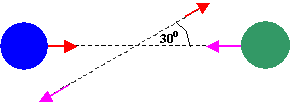
Solution:
- Concepts:
Inelastic
collisions, momentum conservation
- Reasoning:
The collision is inelastic, since energy is not conserved.
The total momentum of the two pucks is zero before the collision and after
the collision.
Let particle 1 be the green puck and particle 2 be the
blue puck. Before and after the collision the ratio of the speeds is v2/v1
= m1/m2 = 1/1.2.
- Details of the calculation:
The final kinetic energy of the system
equals ½ times its initial kinetic energy.
½m1v1i2
+ ½m2v2i2 = 2(½m1v1f2
+ ½m2v2f2).
m1v1i2
+ m2v2i2 = 2(m1v1f2+m2v2f2).
m1v1i2 + 1.2m1(v1i/1.2)2
= 2(m1v1f2 + 1.2m1(v1f/1.2)2).
m1(v1i2 + v1i2/1.2) =
2m1(v1f2 + v1f2/1.2).
v1i2 = 2v1f2, v1f =
0.707v1i.
v1f = 7.07 m/s, v2f = 5.89
m/s.
Problem:
A wooden block of mass M hangs on a massless rope of length L. A bullet of
mass m collides with the block and remains inside the block. Find the minimum
velocity of the bullet so that the block completes a full circle about the point
of suspension.
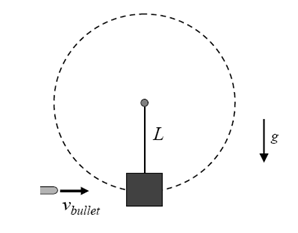
Solution:
- Concepts:
Inelastic collisions, conservation of momentum, circular
motion
- Reasoning:
Let us treat the block/bullet combination as a point
particle. The block and bullet will start moving in a circle. The forces
on the block/bullet are the force of gravity and the tension in the
rope. If the initial speed is large enough so that the block/bullet gains a
height greater than L, then the centripetal acceleration needed to keep the
block/bullet moving on the circle is partly provided by gravity and the
tension decreases. When the tension vanishes then the block/bullet behaves
like a free particle in a gravitational field executes projectile motion.
- Details of the calculation:
Conservation of momentum:
mvbullet
= (M + m)v, v = mvbullet/(M + m)
When the block/bullet
reaches the top of the circle with a speed vtop, so that the
centripetal acceleration vtop2/L > g, then it will
completes a full circle about the point of suspension.
½(M + m)v2
- 2(M + m)gL = ½(M + m)vtop2
vtop2
= v2 - 4gL = [m/(M + m)]2(vbullet)2
- 4gL.
We need [m/(M + m)]2(vbullet)2/L - 4g >
g --> vbullet > (5gL)½ (M + m)/m.
Problem:
A car of total mass M1 = M and velocity v1 makes a
totally inelastic collision at time t = 0 with a second car of mass M2
= 2M at rest. Before the collision a point object of mass m << M was
sitting at the bottom of a frictionless spherical cavity of radius r embodied
inside the first car. For what range of velocities v1 will the
small mass lose contact with the surface of the cavity?
Solution:
- Concepts:
Inelastic collisions, Newton's laws, conservation of
momentum, circular motion, frame transformations
- Reasoning:
Before the collision car 1 and mass m move with uniform
velocity v1. The impulse of the collision changes the velocity
of car 1, and after the collision car 1 moves with uniform velocity v2.
The small mass moves with velocity v = v1 - v2 with
respect to car 1 immediately after the collision. After the collision the
rest frame of car 1 is an inertial frame and we can analyze the problem in
that frame.
- Details of the calculation:
Conservation of momentum: Mv1
= 3Mv2, v2 = v1/3, v = v1 - v2
= 2v1/3.
In the rest frame of car 1 immediately after the
collision we have a particle of mass m at the bottom of a cavity of radius r
moving with velocity v. The particle will start moving in a circle. The
forces on the particle are the force of gravity and the normal force from
the wall of the cavity. If the initial speed is large enough so that the
particle gains a height greater than r, then the centripetal acceleration
needed to keep the particle moving on the circle is partly provided by
gravity and the normal force decreases. When the normal force vanishes then
the particle behaves like a free particle in a gravitational field and
looses contact with the wall.

When ½mv2 < mgr, or v <
(2gr)½, or v1 < (3/2)(2gr)½ the
particle will not break contact with the wall.
When the particle reaches
the top of the cavity with a speed vtop, so that the centripetal
acceleration vtop2/r > g, then it will not break
contact with the wall.
Then ½mv2 = 2mgr + ½mvtop2
> 2mgr + ½mgr = (5/2)mgr.
v > (5gr)½, v1 >
(3/2)(5gr)½.
For initial velocities (3/2)(2gr)½
< v1 < (3/2)(5gr)½ the particle breaks contact with
the wall.
Problem:
A brick is thrown (from ground level) with speed V at an angle θ with respect
to the (horizontal) ground. Assume that the long face of the brick
remains parallel to the ground at all times, and that there is no deformation in
the ground or the brick when the brick hits the ground. If the coefficient
of friction between the brick and the ground is μ what should θ be so that the
brick travels the maximum total horizontal distance before finally coming to
rest?
Solution:
- Concepts:
Projectile motion, impulsive forces
- Reasoning:
The normal force from the ground has to provide an impulse
to reduce the vertical component of the momentum of the brick to zero.
- Details of the calculation:
Let V be the initial speed. The
horizontal speed and initial vertical speed are then Vcosθ and Vsinθ,
respectively. The horizontal distance traveled in the air is the standard
dair = 2V2sinθcosθ/g.
To find the distance traveled
along the ground, we must determine the horizontal speed just after the
impact has occurred. The normal force, N, from the ground is what reduces
the vertical speed from V sinθ to zero, during the impact. So we have
∫
N dt = m V sinθ,
where the integral runs over the time of the impact.
But this normal force (when multiplied by μ to give the horizontal friction
force) also produces a sudden decrease in the horizontal speed, during the
time of the impact. So we have
m ∆vx = -∫ μN dt = -μ m Vsinθ,
which implies ∆vx = -μ Vsinθ.
(We have neglected the effect of
the mg gravitational force during the short time of the impact, since it is
much smaller than the N impulsive force.) Therefore, the brick begins its
sliding motion with speed
v = Vcosθ - μ Vsinθ.
(Note that this is true
only if tanθ < 1/μ. If μ is larger than this, then the horizontal speed
simply becomes zero, and the brick moves no further.)
The friction force
from this point on is μmg, so the acceleration is a = -μg. The distance
traveled along the ground is
dground = (Vcosθ - μ Vsinθ)2/(2μg).
We want to find the angle that maximizes the total distance, dtotal
= dair + dground.
d(dtotal)/dθ = 0.
d(sinθcosθ + cos2θ/(2μ) + μ sin2θ/2)/dθ = 0.
cos2θ
- sin2θ + sinθ cosθ (μ - 1/μ) = 0. cos(2θ) + sin(2θ)½(μ -
1/μ) = 0.
tan(2θ) = 2μ/(1 - μ2).
Using the trigonometric
identity, tan(2θ) = 2 tanθ/(1 - tan2θ) we have tanθ = μ.
Taking the derivative with respect to θ, we see that the maximum total
distance is achieved when tanθ = μ.
Note, however, that the above
analysis is valid only if tanθ < 1/μ. We therefore see that if μ < 1, then
the optimal angle is given by tanθ = μ. (The brick continues to slide after
the impact. If μ > 1, then the optimal angle is θ = 45o. (The
brick stops after the impact, and μ = 45o gives the maximum value
for the dair.
A marble bounces down stairs in a regular manner, hitting each
step at the same place and bouncing the same height above each step.
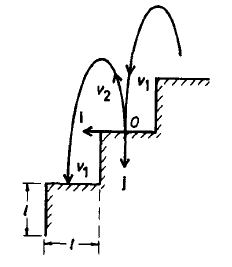
The stair height equals its depth (tread = rise) and the
coefficient of restitution ε is given. Find the necessary
horizontal velocity and bounce height.
(The coefficient of restitution is defined as ε = -vf/vi,
where vf and vi are the vertical velocities just after and
before the bounce. respectively).









